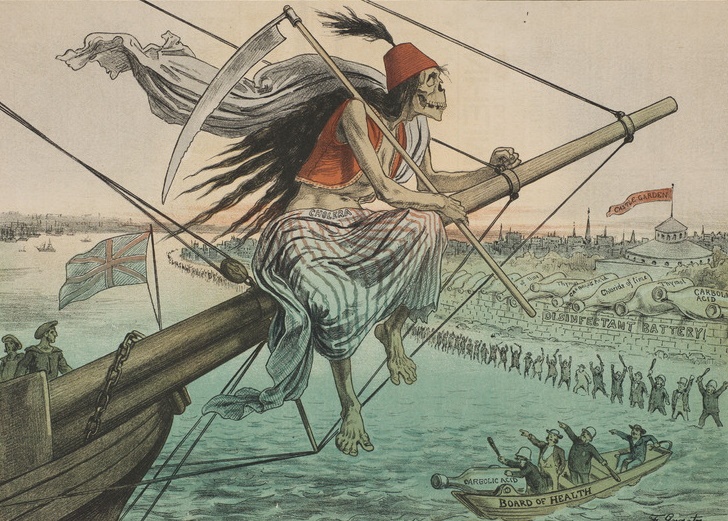One small historical bright side to the COVID-19 pandemic is that, despite a variety of conspiracy theories, it hasn’t (so far) produced riots. That wasn’t the case during an 1831-32 cholera pandemic in England. Other countries saw riots but one of the more notorious ones involved the death of a very young boy in Manchester, England.
The cholera pandemic reached England in October 1831. Between May 29 and June 10, 1832, Liverpool saw eight major street riots sparked by belief that cholera victims were taken to hospitals to be killed by doctors for use in anatomical dissection. In fact, on August 1, Parliament adopted the Anatomy Act to regulate the practice of anatomy because the demand for bodies meant “divers [sic] great and grievous Crimes have been committed … for the single Object of selling” the bodies. (Those who engaged in certain methods of providing bodies, i.e., grave robbers, were also known as “resurrectionists.”)

“Cholera, the unwanted immigrant”
On Friday, August 31, John Brogan, variously reported as three or four years old, fell ill with cholera and was taken to the Swan Street Cholera Hospital in Manchester. He died four hours later. The boy’s grandfather saw the boy’s body while making funeral arrangements on Saturday. Before the funeral Sunday morning, though, he noticed there wasn’t a name on the coffin. According to the Manchester Times, when he insisted it be opened “it was discovered that the head of the corpse had been taken off close to the shoulders and a brick put in its place!” Still, the burial proceeded.
By late afternoon, the grandfather led a large group of people to the cemetery. He dug up the coffin to prove he was telling the truth. Three men carried the coffin to the hospital followed by a crowd yelling, “Burn the hospital!” Some 2,000-3,000 people eventually gathered at the hospital and a mob smashed its windows, threw furniture into the streets and set set the furniture afire. Doctors and nurses escaped by climbing a ladder over a back wall. Police eventually took some rioters to a lock-up but a large part of the crowd followed. The men who’d carried the coffin to the hospital began parading it throughout Manchester, collecting money from those who wanted to look at the body. Meanwhile, the mob at the lock-up began destroying it and several troops of hussars were dispatched. Rioters fled the arriving cavalrymen, who spent the night patrolling the streets.
A surgeon from the hospital tracked down John’s head at the lodging house of Robert Oldham. Oldham, who dispensed medicines at the hospital, had removed the boy’s head after bribing a nurse. The surgeon wrapped the head in a handkerchief and reattached it to the body. The boy’s entire body was interred on the evening of September 3. The Manchester Times reported that a “great crowd of persons” gathered for the service and “the chapel was filled almost to suffocation.”
Although a warrant was issued for Oldham’s arrest, he’d left the hospital upon learning the head had been discovered. He not only fled Manchester, he was believed to have left England. He never faced trial. Ten men appeared in court on riot-related charges on September 3 but charges against half were dismissed for lack of evidence. The three men who paraded the body through town were also arrested but one was discharged because he was only seen begging in the crowds.
The pandemic died out in England before the end of 1832. In light of modern pandemic politics, it’s perhaps ironic the disease was called “Asiatic cholera.”
Infectious diseases … have probably been the most dangerous of enemies of mankind, much more so than war and mass murder.
Folke Henschen, The History and Geography of Disease







